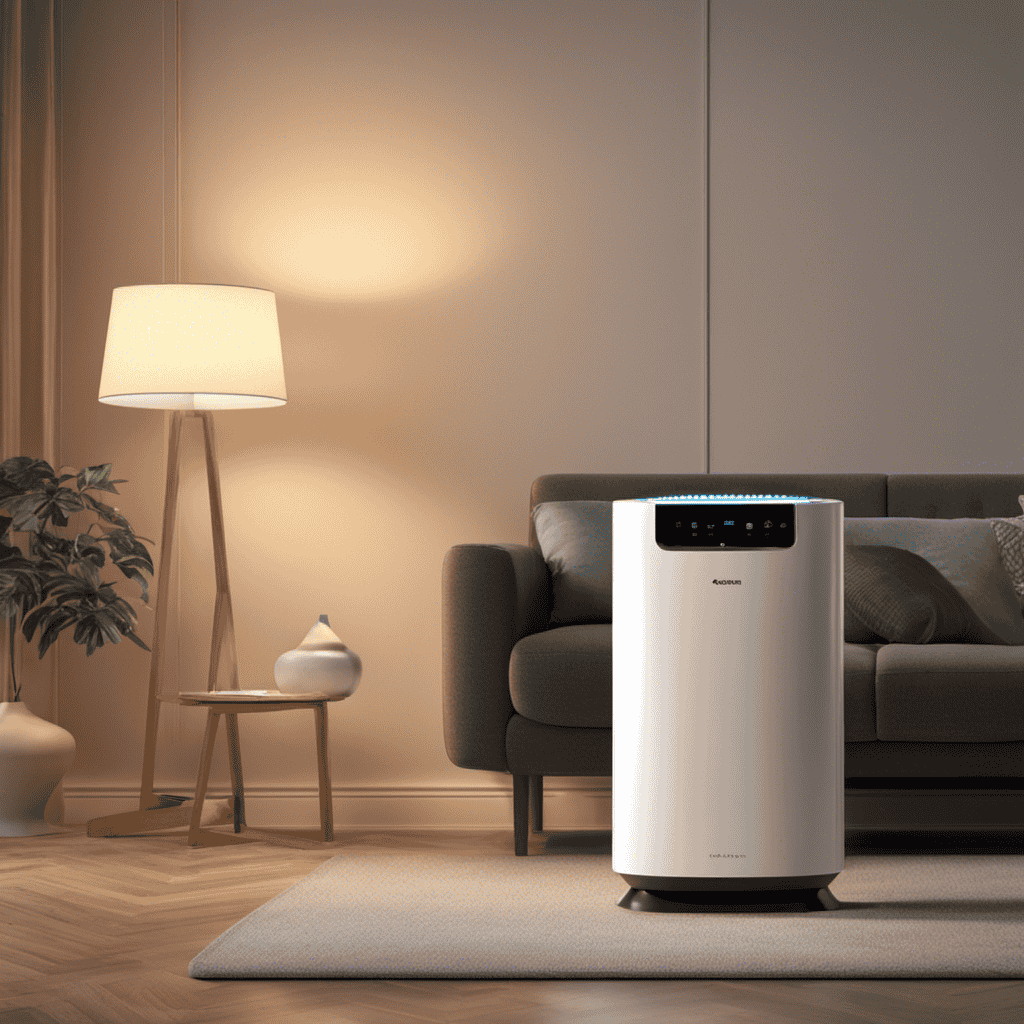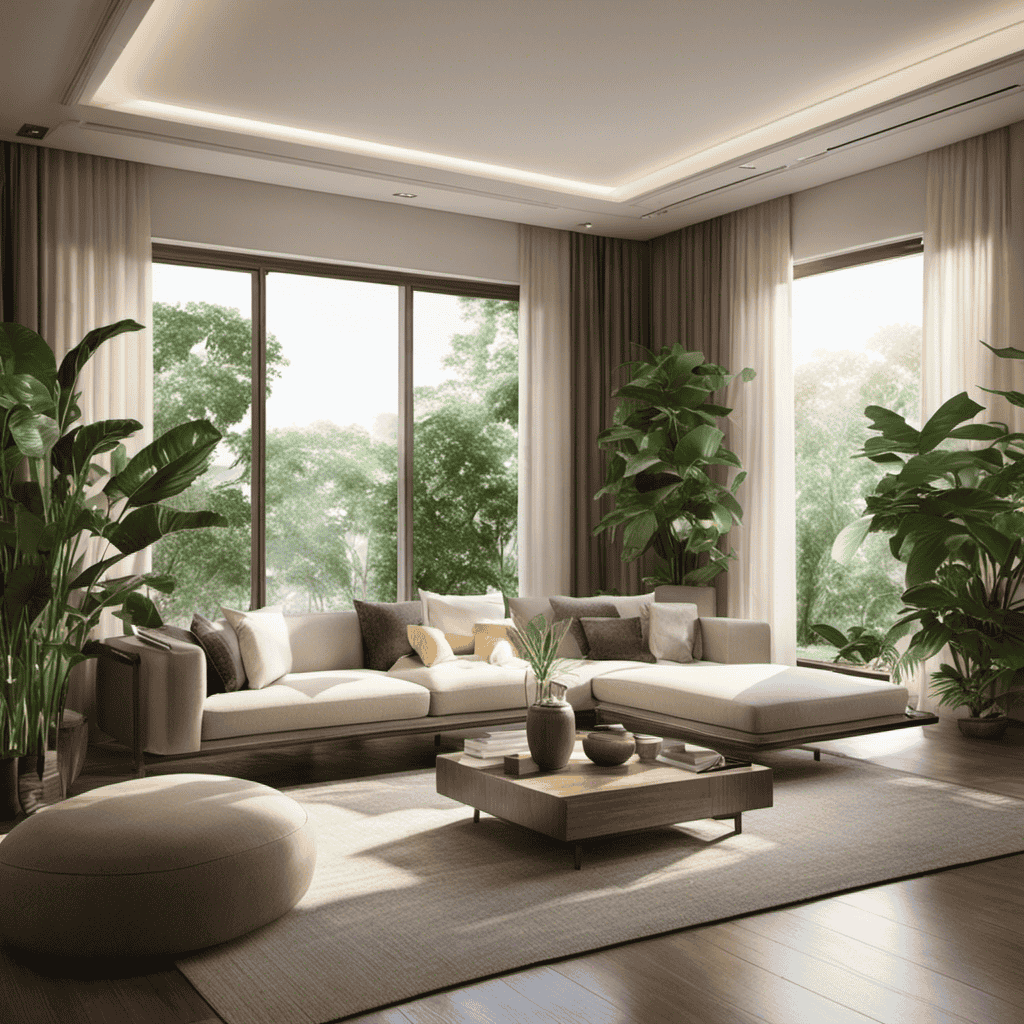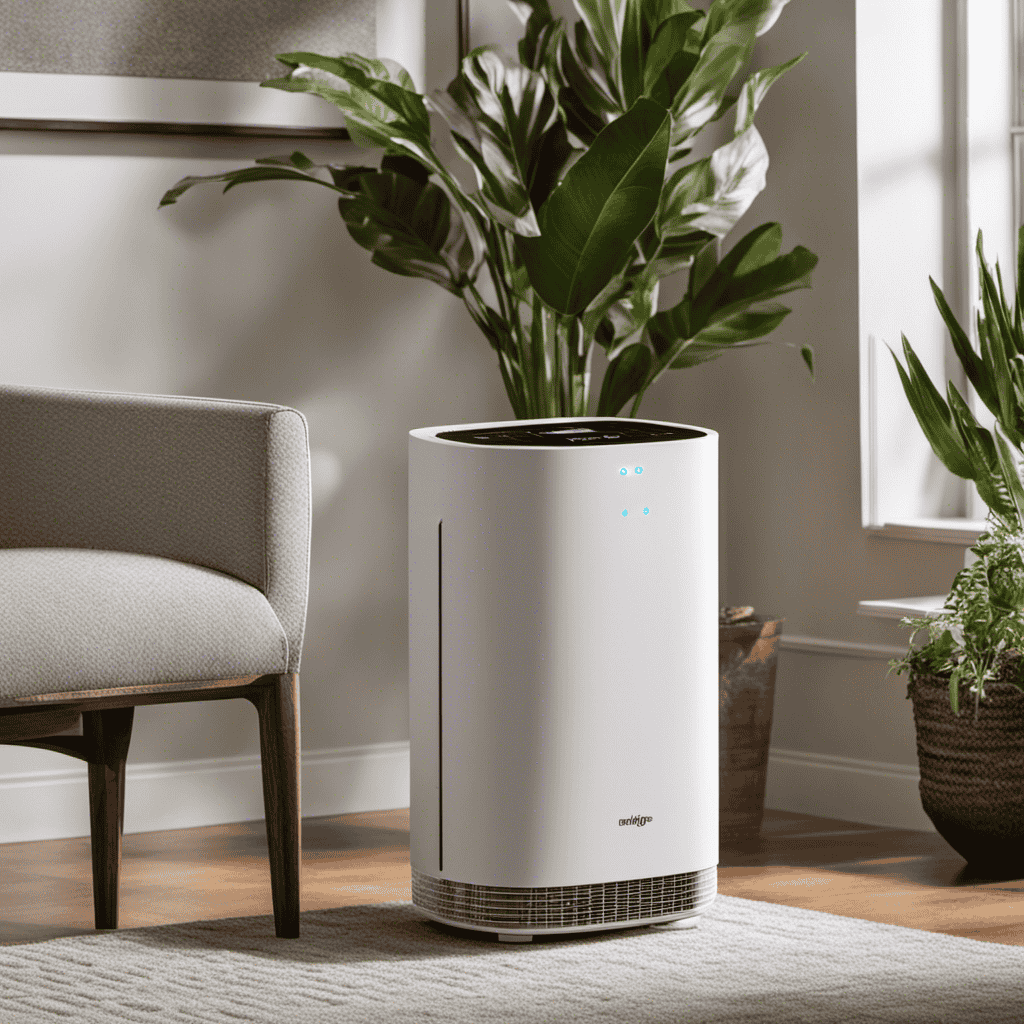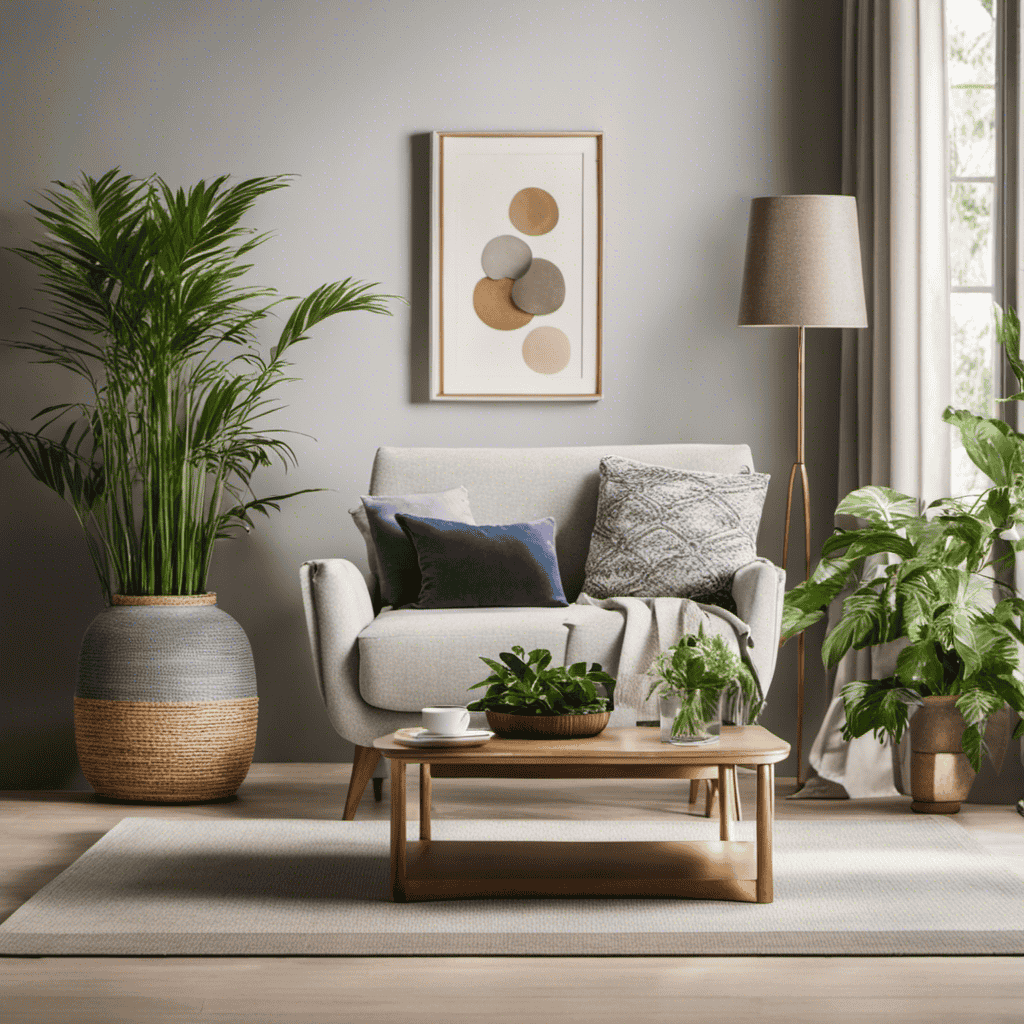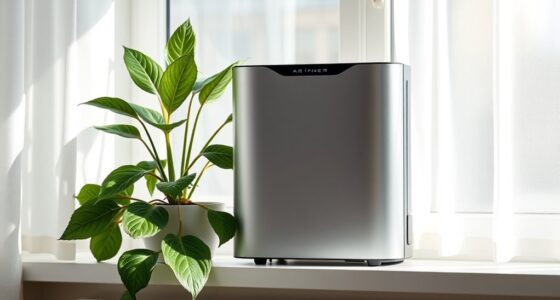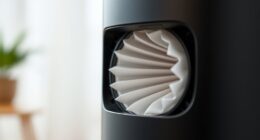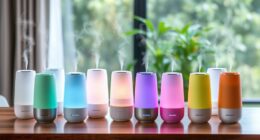As someone who is passionate about air quality, I frequently ponder the question, ‘How long should I keep my air purifier running?’ This is a complex issue with many factors to take into consideration.
In this article, we will explore the benefits of running an air purifier, examine the factors that determine its runtime, and provide recommendations for different scenarios.
So, if you’re curious to optimize your indoor air quality and maximize energy efficiency, join me on this informative journey.
Let’s dive in!
Key Takeaways
- The runtime of an air purifier should be determined based on factors such as room size, air quality level, furniture placement, airflow patterns, and optimal performance.
- It is important to monitor air quality levels using devices that track pollutants, allergens, particulate matter, VOCs, and CO2 levels. This helps in taking necessary steps to improve air quality and maintaining air purifiers for optimal performance.
- Understanding the lifespan of air purifier filters is crucial, including knowing when to replace them and how to extend their lifespan. Regularly replacing filters ensures cleaner air and enhanced longevity of the device.
- Adjusting the runtime of an air purifier should be based on specific needs and preferences, such as monitoring particulate matter, VOCs, or both, considering the size of the space where the device will be used, and finding the right device with desired features and value.
The Benefits of Running an Air Purifier
You’ll be amazed at the benefits you’ll experience by running an air purifier in your home.
Air purifiers are designed to remove airborne pollutants, such as dust, pollen, pet dander, and mold spores, which can have a significant impact on your health.
Regularly assessing the effectiveness of your air purifier can help ensure that you are breathing clean, fresh air.
The health benefits of running an air purifier are numerous. Firstly, it can reduce the risk of respiratory issues by removing harmful particles from the air.
Secondly, it can alleviate allergy symptoms, providing relief for those with allergies or asthma.
Lastly, it can improve overall indoor air quality, leading to a healthier living environment.
Factors to Consider When Determining Air Purifier Runtime
When determining the runtime of an air purifier, there are several important factors to consider.
First, the room size and layout play a crucial role in determining the effectiveness of the purifier. A larger room or one with multiple levels may require a longer runtime to ensure optimal air purification.
Additionally, the air quality level in the room should be taken into account, as a higher level of pollutants may necessitate a longer runtime to achieve clean and healthy air.
Room Size and Layout
To effectively purify the air in your room, consider the size and layout of the space. Room size is an important factor when determining how long to run your air purifier. Larger rooms require longer runtime to ensure proper air circulation and filtration. The air purifier needs enough time to cycle the air in the room and remove pollutants effectively.
On the other hand, smaller rooms may require less runtime as the air purifier can clean the air more quickly. Additionally, the layout of the room plays a role in air purification. Furniture placement, obstacles, and airflow patterns can affect how efficiently the air purifier works.
By considering both room size and layout, you can adjust the runtime of your air purifier for optimal performance.
Transitioning to the next section, let’s now explore the importance of monitoring the air quality level.
Air Quality Level
Monitoring the air quality level is crucial for ensuring a healthy and safe environment in your room. By using air quality monitoring devices, you can keep track of pollutants and allergens in the air. These devices measure various factors such as particulate matter, volatile organic compounds (VOCs), and carbon dioxide levels. With this information, you can take necessary steps to improve the air quality, such as running an air purifier or opening windows for ventilation. Speaking of air purifiers, it is important to regularly maintain them to ensure optimal performance. This includes cleaning or replacing filters, checking for any malfunctions, and following manufacturer’s instructions. By doing so, you can effectively remove pollutants from the air and create a healthier living environment for yourself and others.
| Air Quality Monitoring Devices | Air Purifier Maintenance |
|---|---|
| Measures pollutants and allergens | Clean or replace filters |
| Monitors particulate matter | Check for malfunctions |
| Measures VOCs and CO2 levels | Follow manufacturer’s instructions |
| Provides information for improving air quality | Ensure optimal performance |
Specific Needs and Preferences
It’s important to consider your specific needs and preferences when choosing an air quality monitoring device.
With so many options available, finding the right device can be overwhelming. To start, think about what you want to monitor. Do you want to track particulate matter, VOCs, or both?
Consider the size of the space where you’ll be using the device. Some devices are better suited for smaller rooms, while others are designed for larger areas.
Additionally, think about the features you value most. Do you want a device that can connect to your smartphone or smart home system? Are you looking for a device with a user-friendly interface?
How to Assess Indoor Air Quality
Assessing indoor air quality is crucial for determining how long you should run your air purifier. To assess the air quality in your home, you need to measure the levels of various air pollutants. These pollutants can include dust, pollen, pet dander, mold spores, volatile organic compounds (VOCs), and even bacteria or viruses.
There are several ways to assess indoor air quality, such as using air quality monitors or conducting air sampling tests. Air quality monitors can measure levels of particulate matter, VOCs, and other pollutants in real time, while air sampling tests involve collecting air samples and sending them to a laboratory for analysis.
Understanding Air Purifier Filter Lifespan
When it comes to air purifiers, understanding the lifespan of the filters is crucial. In this discussion, we will explore three key points:
- filter replacement frequency
- ways to extend the filter lifespan
- signs that indicate worn-out filters
Filter Replacement Frequency
To maintain the effectiveness of your air purifier, you should regularly replace the filters. Filter maintenance is crucial for ensuring that your air purifier continues to function optimally.
Over time, filters become clogged with pollutants and lose their ability to effectively capture airborne particles. Regularly replacing the filters not only ensures cleaner air but also enhances the longevity of your air purifier.
The frequency of filter replacement depends on various factors such as the type of filter, the level of indoor air pollution, and the manufacturer’s recommendations. It is generally recommended to replace the filters every 3 to 6 months.
While filter replacement may incur some cost, it is a worthwhile investment to maintain the performance and cost-effectiveness of your air purifier in the long run.
Extending Filter Lifespan
In order to maximize the lifespan of air purifier filters and increase their efficiency, there are several strategies that can be employed.
Firstly, regular cleaning of pre-filters can help to reduce the amount of debris and particles that reach the main filter, thus extending its lifespan.
Additionally, using high-quality filters that are specifically designed for the air purifier model can greatly improve their efficiency and lifespan.
It is also important to ensure that the air purifier is operated under optimal conditions, such as in a well-ventilated room and away from potential sources of contamination.
Finally, regularly monitoring and replacing filters when necessary is crucial to maintain the effectiveness of the air purifier and avoid overworking the filters.
Signs of Worn-Out Filters
You may notice reduced airflow and an increase in dust particles in your home, indicating that it’s time to replace your worn-out filters. Regular filter maintenance is crucial for optimal performance of your air purifier. Here are some signs that your filters are no longer effective:
-
Reduced airflow: If you feel that the air circulation in your home has decreased, it could be a sign that your filters are clogged and need replacement.
-
Increased dust particles: If you notice an accumulation of dust particles on surfaces, even after regular cleaning, it means that your filters are not effectively capturing airborne particles.
-
Strong odors: If unpleasant odors persist in your home, it suggests that the filters are not effectively removing volatile organic compounds (VOCs) and other pollutants.
-
Allergy symptoms: If you or your family members experience an increase in allergy symptoms, such as sneezing or coughing, it may be due to the filters not efficiently trapping allergens.
-
Higher energy consumption: A worn-out filter can cause your air purifier to work harder, resulting in increased energy consumption.
To ensure the continued performance of your air purifier, it is important to regularly check and replace your filters according to the manufacturer’s recommendations.
Recommended Air Purifier Runtime for Allergies
The recommended air purifier runtime for allergies is typically around 8-12 hours per day. This runtime is based on scientific research and analysis, which has shown that running the air purifier for this duration can significantly reduce airborne allergens and improve air quality.
For individuals with respiratory conditions, such as asthma or allergies, consistent air purification is crucial in minimizing symptoms and improving overall respiratory health. Children, who are more susceptible to respiratory issues, can also benefit from a consistent air purifier operation.
The Importance of Consistent Air Purifier Operation
When considering the optimal runtime for effectiveness of an air purifier, it is important to understand the continuous purification benefits it offers.
By operating the purifier consistently, it can efficiently remove airborne contaminants and maintain clean air quality.
Inconsistency in operation may lead to health implications, as it allows pollutants to accumulate and reduces the effectiveness of the purification process.
Optimal Runtime for Effectiveness
To maximize effectiveness, it’s important to consider the optimal runtime for an air purifier. The recommended duration for running an air purifier varies depending on factors such as room size and air quality. However, there are general guidelines to follow.
- Run the air purifier continuously in rooms with high levels of pollutants or allergens.
- In rooms with moderate pollution, run the purifier for at least 8 hours a day.
- For rooms with low pollution, running the purifier for 4-6 hours a day is sufficient.
Prolonged use of an air purifier can lead to dryness in the air, which may cause discomfort. It’s important to monitor the air quality regularly to adjust the runtime accordingly.
Considering the optimal runtime ensures that the air in your environment remains clean and healthy. Continuous purification benefits include improved indoor air quality, reduced respiratory issues, and minimized exposure to harmful pollutants.
Continuous Purification Benefits
You can experience improved indoor air quality, reduced respiratory issues, and minimized exposure to harmful pollutants by continuously purifying the air. Continuous operation of an air purifier offers a range of health benefits that can positively impact your well-being.
By running the air purifier continuously, you ensure that the air in your environment is constantly being filtered and cleaned. This helps to remove airborne particles such as dust, pollen, pet dander, and mold spores that can trigger respiratory issues and allergies.
Additionally, continuous purification can reduce the presence of harmful pollutants like volatile organic compounds (VOCs) and smoke particles, which can have long-term detrimental effects on your health. By keeping the air constantly purified, you create a healthier living space and promote overall well-being.
Health Implications of Inconsistency
Maintaining consistent operation of an air purifier can have significant health implications, ensuring that harmful pollutants are continuously filtered and reducing the risk of respiratory issues and allergies. Inconsistent use of an air purifier can lead to a variety of health risks. Here are some key points to consider:
- Pollen and allergens can accumulate in the air if the purifier is not running consistently, increasing the likelihood of allergic reactions.
- Airborne viruses and bacteria may not be effectively removed if the purifier is turned off intermittently, putting individuals at a higher risk of infections.
- High levels of indoor air pollutants, such as volatile organic compounds (VOCs), can cause headaches, dizziness, and other health problems if not consistently filtered.
- Asthma and other respiratory conditions can worsen if the air purifier is not running continuously to remove triggers from the air.
- Mold spores can grow and spread in the absence of consistent air purification, leading to respiratory issues and allergies.
Adjusting Air Purifier Runtime Based on Room Size
When deciding how long to run your air purifier, take into account the size of the room. Adjusting air purifier duration based on room size is essential to ensure optimal air purification.
Larger rooms require more time for the air purifier to effectively circulate and clean the air. This is because larger rooms have a greater volume of air that needs to be filtered.
On the other hand, smaller rooms require less time as the air purifier can quickly cycle through the air. To determine the appropriate duration, consider the recommended air changes per hour (ACH) for your specific air purifier model.
ACH refers to the number of times the air in a room is cleaned within an hour. By understanding the room size and ACH, you can adjust the runtime of your air purifier for maximum efficiency.
Air Purifier Runtime for Pet Owners
As a pet owner, it’s important to understand the optimal runtime for your air purifier to effectively remove pet dander and odors from your home.
Several factors can affect the runtime. These include the size of your space, the number of pets you have, and the level of allergens present.
To maximize energy efficiency, consider implementing tips such as using a timer, maintaining the filters regularly, and placing the air purifier in strategic locations within your home.
Optimal Pet Owner Runtime
You’ll want to consider how long you should run your air purifier if you have pets. Pet allergies can be a real problem for many people, and one of the main culprits is pet dander. These tiny particles can easily become airborne and cause allergic reactions in sensitive individuals. To effectively reduce pet dander and alleviate symptoms, it is important to run your air purifier for an optimal amount of time.
Here are some factors to consider:
-
Pet shedding: If your pet sheds a lot, you may need to run the air purifier for longer periods to keep up with the constant release of pet dander.
-
Allergy severity: If you or someone in your household has severe pet allergies, it is recommended to run the air purifier continuously to maintain a clean and allergen-free environment.
-
Room size: Larger rooms may require longer running times to ensure proper air filtration.
-
Air purifier efficiency: The effectiveness of your air purifier will also play a role in determining the optimal runtime.
-
Personal preference: Ultimately, the length of time you run your air purifier will depend on your personal comfort and the level of pet allergens in your home.
Factors Affecting Runtime
Factors such as pet shedding, allergy severity, room size, air purifier efficiency, and personal preference all influence the optimal runtime for your air purifier.
Pet shedding can introduce more dander and hair into the air, requiring longer purifier runtime to maintain clean air.
Allergy severity also plays a role, as individuals with severe allergies may require extended runtime to alleviate symptoms.
Room size is an important consideration; larger rooms may require longer runtime to effectively circulate and clean the air.
Air purifier efficiency is another factor to consider, as higher efficiency models may require less runtime to achieve the same level of air purification.
Lastly, personal preference should be taken into account, as some individuals may prefer a continuous clean air environment.
It is important to monitor air pollution levels and perform regular air purifier maintenance to ensure optimal performance and maximize runtime.
Transitioning to energy efficiency tips, there are several strategies to reduce energy consumption while still maintaining clean air.
Energy Efficiency Tips
To maximize efficiency and reduce energy consumption, consider adjusting the settings on your device. Here are some energy efficiency tips for your air purifier:
- Set the fan speed to the lowest setting, as this consumes less energy.
- Use the timer function to schedule when the air purifier should be running.
- Clean or replace the filters regularly to maintain optimal performance and extend their lifespan.
- Place the air purifier in a central location to ensure proper air circulation.
- Consider the size and coverage area of the air purifier, as running a larger unit in a smaller room may be unnecessary.
By following these tips, you can reduce energy usage without compromising the effectiveness of your air purifier.
Now, let’s explore the specific air purifier runtime for smokers.
Air Purifier Runtime for Smokers
If you’re a smoker, it’s important to consider the runtime of your air purifier to effectively filter out smoke particles. Smoke particles can linger in the air and settle on surfaces, leading to unpleasant odors and potential health risks. To determine the optimal runtime for your air purifier, you need to consider the size of the room, the strength of the purifier, and the level of smoke pollution. A good rule of thumb is to run the air purifier for at least 4 hours a day in a small to medium-sized room. However, if you smoke heavily or have poor ventilation, you may need to run it for longer periods. It’s also important to regularly clean or replace the filters to maintain the purifier’s effectiveness.
| Factors to Consider | Air Purifier Runtime |
|---|---|
| Room Size | Small to Medium |
| Smoke Pollution Level | Heavy |
| Ventilation | Poor |
| Filter Maintenance | Regular Cleaning |
How Long Should I Run an Air Purifier for Odor Control
When it comes to controlling odors in your home, running an air purifier can be an effective solution. The effectiveness of an air purifier in removing odors depends on various factors, including the type of purifier and the size of the room.
To ensure optimal odor control, it is recommended to run your air purifier for an appropriate amount of time. Here are a few factors to consider:
-
Air purifier effectiveness: Different air purifiers have varying levels of effectiveness in removing odors. Some purifiers are specifically designed to target and eliminate odors, while others may have limited odor control capabilities.
-
Odor source: The intensity and duration of odors in your home will determine how long you should run the air purifier. Strong and persistent smells may require longer runtime.
-
Room size: The size of the room also plays a role in determining the recommended runtime. Larger rooms may require a longer runtime to effectively remove odors.
-
Air purifier features: Certain air purifiers have features like adjustable fan speeds or programmable timers. Utilizing these features can help you customize the runtime to suit your odor control needs.
-
Maintenance: Regularly cleaning and changing the filters in your air purifier is essential for maintaining its effectiveness in odor control. Neglecting maintenance can decrease the purifier’s efficiency and effectiveness.
Considering these factors, it is recommended to run your air purifier for a minimum of 4-6 hours daily for effective odor control. Adjust the runtime based on the intensity of odors and the size of the room. Remember to maintain your air purifier properly to ensure its optimal performance in removing odors.
Air Purifier Runtime for Asthma Relief
Running an air purifier can provide relief for asthma symptoms. When it comes to air purifier runtime for dust mites and children with asthma, it is important to consider the specific needs of each case.
Dust mites are a common trigger for asthma, and running the air purifier for longer periods can help reduce their presence in the air. For children with asthma, it is recommended to run the air purifier continuously or for extended periods, especially in their bedrooms where they spend most of their time. This helps maintain clean air and minimize asthma triggers.
However, it is important to optimize air purifier runtime for energy efficiency as well. By following certain guidelines, we can ensure that the air purifier runs efficiently while still providing the necessary relief for asthma symptoms.
How to Optimize Air Purifier Runtime for Energy Efficiency
To optimize your air purifier’s runtime for energy efficiency, consider adjusting the fan speed and using the timer function. By adjusting the fan speed, you can control the airflow distribution and ensure that the air purifier is not running at maximum power when it is not necessary. This will help save energy and prolong the runtime of the device. Additionally, using the timer function allows you to set specific periods of operation, reducing the overall runtime.
To further optimize energy efficiency and enhance performance, here are some additional tips:
- Clean or replace the air filters regularly to maintain optimal airflow and prevent the air purifier from working harder than necessary.
- Place the air purifier in a central location to maximize its effectiveness and minimize the need for multiple units.
- Keep doors and windows closed to prevent outside pollutants from entering the space, reducing the workload on the air purifier.
- Use the lowest fan speed setting that still provides adequate air purification.
- Consider using a noise-reducing cover or placing the air purifier on a soft surface to minimize noise disturbances.
How Long Should I Run an Air Purifier at Night
At night, I can maximize the effectiveness of my air purifier by running it for several hours while I sleep. But how long should I run it?
Assessing the effectiveness of an air purifier involves considering factors such as room size, air quality, and the specific needs of individuals. To determine the duration, one must assess the air purifier’s Clean Air Delivery Rate (CADR), which measures its efficiency in removing pollutants.
The general recommendation is to run the air purifier for at least 4-6 hours at night, ensuring that it covers the entire sleep cycle. However, if the air quality is poor or there are specific health concerns, it may be necessary to run it longer.
Regular monitoring of air quality and observing any improvements can help in determining the ideal duration for running the air purifier.
Air Purifier Runtime for Seasonal Allergies
For individuals with seasonal allergies, it’s important to assess the runtime of their air purifier to effectively reduce allergens in the air.
Hay fever, a common type of seasonal allergy, can be triggered by various airborne allergens such as pollen, mold spores, and dust mites.
Adjusting the air purifier runtime according to the different seasons can help alleviate symptoms and improve indoor air quality. Here are some key considerations:
- Monitor pollen levels in your area and increase runtime during high pollen seasons.
- During spring and fall, when pollen counts are typically higher, run the air purifier for longer periods, especially in rooms where you spend most of your time.
- Keep windows closed during peak pollen hours and rely on the air purifier to filter out allergens.
- Regularly clean and maintain your air purifier to ensure optimal performance.
- Consult with an allergist or healthcare professional for personalized advice on air purifier runtime for hay fever.
How to Monitor Air Quality to Determine Air Purifier Runtime
Make sure you regularly check the air quality to determine how long your air purifier should be running.
Monitoring devices such as air quality sensors can provide valuable information about the contaminants present in the air. These sensors measure various parameters such as particulate matter, volatile organic compounds, and carbon dioxide levels.
By monitoring these factors, you can assess the air quality and adjust the runtime of your air purifier accordingly. For example, if the sensor detects high levels of allergens or pollutants, it’s advisable to run the purifier for longer periods to effectively remove these harmful substances from the air.
On the other hand, if the air quality is relatively good, you can reduce the runtime of the purifier to conserve energy.
Monitoring devices like air quality sensors provide accurate data to help you optimize the runtime of your air purifier for maximum efficiency and effectiveness.
Frequently Asked Questions
Can I Run an Air Purifier for Too Long?
Yes, running an air purifier for too long can be detrimental. However, there are benefits to running it overnight, such as reducing allergens. To optimize energy efficiency, consider using a timer or adjusting the fan speed.
How Often Do I Need to Replace the Filters in My Air Purifier?
I should clean my air purifier filters every 3-6 months or as recommended by the manufacturer. Signs that the filters need replacement include reduced airflow, increased dust accumulation, and a decrease in overall air quality.
Are There Any Health Risks Associated With Running an Air Purifier for Too Long?
Running an air purifier for excessive periods can have negative effects on health. Prolonged exposure to purified air may lead to dryness in the nasal passages and throat, causing discomfort. It is important to use the device in moderation.
Can I Run Multiple Air Purifiers in Different Rooms at the Same Time?
Yes, I can run multiple air purifiers in different rooms simultaneously. Doing so can provide several benefits such as improved air quality throughout the entire house and targeted purification in specific areas.
Does the Size of the Room Affect the Runtime of the Air Purifier?
The size of the room can impact the effectiveness of an air purifier. Larger rooms may require a longer runtime to achieve the desired air quality. However, running an air purifier for too long can increase energy consumption.
Conclusion
In conclusion, the runtime of an air purifier depends on various factors. These include indoor air quality, filter lifespan, allergies, energy efficiency, and seasonal changes. It is important to regularly assess the air quality and adjust the purifier’s runtime accordingly.
For example, in a case study conducted in a home with severe allergies, running the air purifier continuously for 24 hours significantly reduced symptoms and improved overall air quality. Therefore, understanding these factors and optimizing the air purifier’s runtime can effectively improve indoor air quality and provide a healthier living environment.
